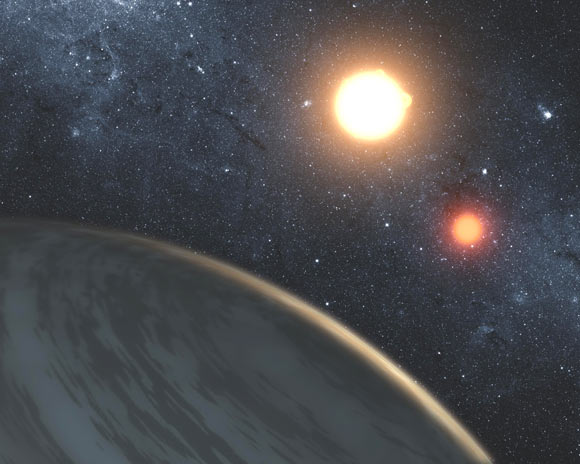TESS Finds Still-Forming Gas Giant in Binary Star System | Astronomy – Sci-News.com
Astronomers using NASA’s Transiting Exoplanet Survey Satellite (TESS) have discovered an exoplanet planet larger than Neptune but smaller than Saturn in orbit around a star in the 45-million-year-old binary system DS Tuc (also known as HD 222259 and TIC 410214986).

An artist’s rendering of a gas giant in a binary stellar system. Image credit: NASA / JPL-Caltech / T. Pyle.
“One of the overall goals of astronomy is understanding the big picture of how we got here, how solar systems and galaxies take shape and why,” said Dr. Elisabeth Newton, an astronomer at Dartmouth College.
“By finding solar systems that are different from our own — especially young ones — we can hope to learn why Earth and our own Solar System evolved in the ways that they did.”
The planet discovered by Dr. Newton and her colleagues can be considered a ‘pre-teen’ in planetary time.
Named DS Tuc Ab, the planet is no longer growing, but, because of its young age, it is still undergoing rapid changes like losing atmospheric gas as a result of the radiation coming from its host star.
It orbits DS Tuc A, the G6-class primary component of the binary stellar system DS Tuc, which is located approximately 151 light-years away in the constellation of Tucana and belongs to the Tucana-Horologium moving group of stars.
DS Tuc Ab makes one full orbit around its star in just 8.1 days and is about 5.7 times the size of Earth, between the sizes of Neptune and Saturn. Given the size, it likely has a composition similar to that of the giant planets in our Solar System.
The planet was first observed by TESS in November of 2018 and was confirmed by Dr. Newton’s team in March 2019 using data from NASA’s Spitzer Space Telescope and other ground- and space-based observatories, such as the South African Large Telescope (SALT).
“We were really excited when we confirmed this discovery because the planet orbits such a bright, well-known young star,” Dr. Newton said.
Planets are larger when first formed and are thought to become smaller over time as they cool and lose atmosphere. Because DS Tuc Ab is still forming, the astronomers hope to detect atmosphere evaporation in action.
“We hope that by seeing this planet’s atmosphere, we can provide a snapshot of what planets look like at a young age,” Dr. Newton said.
The team’s paper was published in the Astrophysical Journal Letters.
_____
Elisabeth R. Newton et al. 2019. TESS Hunt for Young and Maturing Exoplanets (THYME): A Planet in the 45 Myr Tucana-Horologium Association. ApJL 880, L17; doi: 10.3847/2041-8213/ab2988





